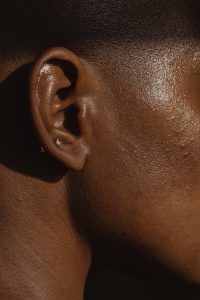Tinnitus- is a ringing sound in the ears that is a sign of damage to the inner ear.
Tinnitus is very common. According to different scientists, 35-45% of the adult population hear tinnitus from time to time, about 8% experience constant ear noise, and 0.5-1% have decompensated tinnitus interfering with daily life and leading to such negative consequences as sleep disturbances, irritability, social isolation, depression, etc..
By itself tinnitus is not a disease, it is only a symptom of many diseases, and not only the ear, but also other organs and systems.
As you know, tinnitus does not respond to treatment, however, there are several ways to manage it.
Since tinnitus is perceived as noise, there is no objective way to measure or physically treat it. Tinnitus therapy uses low noise levels along with psychological techniques to help the patient become less aware of the ringing experience.
However, to one degree or another, ear noise always indicates a change in normal functioning auditory analyzer and may be due to background activity, localized at the level of any neuron of the auditory pathway. From 53% to 80% of patients with tinnitus have hearing loss.
Table of Contents
The History of Tinnitus retraining therapy
Tinnitus retraining therapy was developed by Dr. Pavel Jastreboff in the mid-1980s and officially published in the medical community in 1990. As a professor at Yale University, Jastreboff did research to detect different tones in the ears in order to develop treatments for different noise levels.
After interviewing people with tinnitus, he learned that not all people were even bothered by the noise, and some got used to it.
Jastreboff’s study also concluded that there was no significant difference in the amount of noise, but rather the perception of noise by the individual.

After his research concluded that some tinnitus sufferers might ignore ringing sounds, Jastreboff came up with the central principles of his tinnitus retraining model.
It was based on the idea that all sensory information resides at multiple levels of the nervous system and ultimately ends up in the cerebral cortex, the region of the brain responsible for sensing perception.
The meaning of Tinnitus Retraining Therapy
He believed that noises that occur on a daily basis, such as the buzzing of the refrigerator or passing cars, are not so noticeable to people because their nervous system knows that the noises are minor and do not require an auditory signal in the cerebral cortex.
Jastreboff believed that the nervous system could be trained to process ringing sounds in the ears as a minor technique called habituation.
The first condition for tinnitus retraining therapy is to eliminate any negative psychological associations associated with tinnitus sounds, and the second condition is to maintain the patient’s ability to detect noise during treatment.
If the patient does not know how to be aware of the murmurs during treatment, he or she will not be able to actively retrain them.
So,The purpose of TRT is to manage the response to tinnitus, thereby allowing habituation and return to previous levels of perception.
What is the effect of Tinnitus Retraining Therapy?
Tinnitus refresher therapy typically lasts one to two years and involves the patient wearing a noise-transmitting device behind the ear when tinnitus is most common. The therapist transmits low broadband noise through the device because the silence can temporarily worsen tinnitus.
Because the noise transmission device covers the silence that amplifies the tinnitus, the patient may begin to feel less annoyed by the noise and stop associating negative emotions with tinnitus.
Broadband frequencies are thought to stimulate the nervous system to reprogram it to end up treating tinnitus as a minor noise rather than a stressful or annoying noise.

An alternative to TRT is to mask tinnitus, using noise, music, or other environmental sounds to darken or mask ear noise.
Sound therapy as an Alternatives of Tinnitus Retraining Therapy
Sound therapy is the use of external noises to mask annoying tinnitus manifestations. This can be white noise, other special masking noises, soft music, or even a sound or melody of your choice.
Many hearing aids offer various forms of sound therapy. Because tinnitus and hearing loss are often linked, using hearing aids can be an effective way to find relief.
The main goal is to retrain the brain, to let it understand that the noise felt during tinnitus is not an important sound, but just a part of the background noise. The following visual analogy will help you understand how sound therapy works.
Tinnitus is like a bright star in the night sky. The contrast between the shining star and the surrounding black background is great, it attracts attention to the star, it becomes difficult not to pay attention to it.
But the same star in the daytime sky completely merges with the background light, it is almost impossible to detect, although it still remains in its place.
Tinnitus retraining Therapy and Hearing Loss
If tinnitus is associated with hearing loss, it is advisable to use hearing aids. In some cases, only the use of a hearing aid apparatus (CA) improves the patient’s condition, diverting his attention from the ear noise and natural tinnitus masking with louder environmental signals, and in quiet conditions – operating noise microphone.
How does Tinnitus Retraining Therapy start?
At the appointment, some basic steps will be taken to assess the condition.
Don’t be surprised when a hearing test is ordered – most people with chronic tinnitus have some degree of hearing loss, often very mild and subtle. Therefore, a hearing test is always included in the tinnitus diagnostic complex.
Step 1. Assess tinnitus using a questionnaire
Step 2. Tinnitus Analysis and Hearing Test
Step 3. Explaining your results from steps 1 and 2
Step 4. Explaining what solutions exist for your form of tinnitus
Step 5. Consulting and goal setting

You may also be given referrals to other specialists, for example, an ENT doctor, physiotherapist, dentist.
What are tinnitus Management Programs?
A large number of tinnitus management programs are aimed at teaching the brain to distract from perceived tinnitus sounds and focus on important things and sounds. By relegating tinnitus sounds to the background, people with tinnitus can again pay full attention to what interests them.
ReSound Relief is one of the most useful tinnitus management apps available on the market today. As part of the tinnitus management program, ReSound Relief offers a combination of sound therapy, relaxation exercises, meditation and advice, anytime, anywhere.
Phonak ComPilot is a different tinnitus management hearing system. This system is the perfect complement to sound therapy. It allows you to select sounds from the standard sound library provided by the app, or combine sounds with the contents of your smartphone’s music library.
If you are used to falling asleep to soothing sounds, the built-in timer function will come in handy for you. With Phonak ComPilot, the audio stream from the app is directed directly to your hearing aid with Tinnitus Balance.
Final Words
There is no evidence that tinnitus retraining therapy or any other therapy can reduce or eliminate tinnitus.
An alternative to TRT is to mask tinnitus, using noise, music, or other environmental sounds to darken or mask tinnitus.
Tinnitus and stress form a vicious circle: tinnitus leads to stress, which in turn increases the intensity of tinnitus.
Dealing with stress and anxiety, such as listening to soothing and relaxing sounds, exercise, and meditation, can help you find peace and relief from your tinnitus.
None of the existing tinnitus therapies provide immediate relief. Getting control of your tinnitus takes time and patience.
You will need to develop some skills and learn how to apply certain strategies on a daily basis. Be patient, as many people find relief from tinnitus, especially with the guidance of a qualified hearing care professional.
FAQ
1. What’s the purpose of TRT?
The purpose of TRT is to manage the response to tinnitus, thereby allowing habituation and return to previous levels of perception.
2. Does Tinnitus Retraining Therapy give you a 100% result?
No, there is no evidence that tinnitus retraining therapy or any other therapy can reduce or eliminate tinnitus.
3. What Tinnitus Retraining Therapy includes?
The technique includes the use of audio maskers (white noise, noise of the sea, etc.), classes with a psychotherapist and physical exercises (yoga, physiotherapy exercises, breathing exercises, auto-training, osteopathy and
etc.). There are industrially produced audiomaskers – devices, reproducing sounds similar in frequency to the patient’s tinnitus, or
various sounds of the environment, listening to which helps to the patient to “drown out” own ear noise
4. How to start Tinnitus Retraining Therapy?
From the very beginning, You must go to the specialist.
To understand which specialist to seek advice from, you need to understand what type of tinnitus you have developed.
Acute tinnitus: A sudden onset of ringing in the ears, with no apparent cause or explanation, for a total duration of less than three months.
For any sudden or sudden changes in hearing or ear condition, you should see an ENT specialist. This includes cases of acute tinnitus, any noticeable change in hearing or perception of ambient sounds.
Many of the diseases are completely curable, but treatment must be started early.
Chronic tinnitus: Persistent ringing in the ears lasting more than three months. We strongly recommend that you consult with an audiologist who has practical experience with tinnitus.
These specialists have in-depth knowledge of the various options for tinnitus correction, they will be able to discuss your needs in detail with you and suggest suitable solutions.
5. What is sound therapy as an alternative method of tinnitus retraining therapy?
When additional distracting sounds enter the ears, tinnitus becomes less noticeable. The goal of this type of tinnitus therapy is to help you pay less attention to it, which will provide relief.
The main goal is to retrain the brain, to let it understand that the noise felt during tinnitus is not an important sound, but just a part of the background noise.
6. What sounds are used in an alternative method of tinnitus retraining therapy?
Usually sounds used with for this purpose, it is amplified sounds of hearing aids, sounds of the environment
and music or noise of noise generators. Using sounds like this helps to minimize the contrast between the ear
noise and environment to protect from annoying sounds. This also allows the brain to receive the required amount of incoming sounds and not overreact if it hears too few sounds.
Sounds can also help you relax. So how stress often leads to tinnitus, relaxation and stress reduction are key ingredients in the fight with stress
